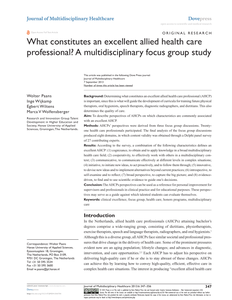Introduction: The transition from hospital to home is often suboptimal, resulting in patients not receiving the necessary allied healthcare after discharge. This may, in turn, lead to delayed recovery, a higher number of readmissions, more emergency department visits and an increase in mortality and healthcare costs. This study aimed to gain insight into patients' experiences, perceptions, and needs regarding hospital-to-home transition, focusing on allied healthcare as a first step towards the development of a transitional integrated allied healthcare pathway for patients with complex care needs after hospital discharge. Methods: We conducted semistructured interviews with patients. Participants were recruited from universities and general hospitals in the Amsterdam region between May and July 2023. They were eligible if they (1) were discharged from the hospital minimally 3 and maximally 12 months after admission to an oncologic surgery department, internal medicine department, intensive care unit, or trauma centre, (2) received hospital-based care from at least one allied healthcare provider, who visited the patient at least twice during hospital admission, (3) spoke Dutch or English and (4) were 18 years or older. Interviews were audio-recorded and transcribed verbatim. We performed a thematic analysis of the interview data. Results: Nineteen patients were interviewed. Three themes emerged from the analysis. ‘Allied healthcare support during transition’ depicts patients' positive experiences when they felt supported by allied health professionals during the hospital-to-home transition. ‘Patient and family involvement’ illustrates how much patients value the involvement of their family members during discharge planning. ‘Information recall and processing’ portrays the challenges of understanding and remembering overwhelming amounts of information, sometimes unclear and provided at the wrong moment. Overall, patients' experiences of transitional care were positive when they were involved in the discharge process. Negative experiences occurred when their preferences for postdischarge communication were ignored. Conclusions: This study suggests that allied health professionals need to continuously collaborate and communicate with each other to provide patients and their families with the personalized support they need. To provide high-quality and person-centred care, it is essential to consider how, when, and what information to provide to patients and their families to allow them to contribute to their recovery actively. Patient or Public Contribution: The interview guide for this manuscript was developed with the assistance of patients, who reviewed it and provided us with feedback. Furthermore, patients provided us with their valuable lived experiences by participating in the interviews conducted for this study.
DOCUMENT

Background: Determining what constitutes an excellent allied health care professional (AHCP) is important, since this is what will guide the development of curricula for training future physical therapists, oral hygienists, speech therapists, diagnostic radiographers, and dietitians. This also determines the quality of care.Aim: To describe perspectives of AHCPs on which characteristics are commonly associated with an excellent AHCP.Methods: AHCPs’ perspectives were derived from three focus group discussions. Twenty-one health care professionals participated. The final analysis of the focus group discussions produced eight domains, in which content validity was obtained through a Delphi panel survey of 27 contributing experts.Results: According to the survey, a combination of the following characteristics defines an excellent AHCP: (1) cognizance, to obtain and to apply knowledge in a broad multidisciplinary health care field; (2) cooperativity, to effectively work with others in a multidisciplinary con¬text; (3) communicative, to communicate effectively at different levels in complex situations; (4) initiative, to initiate new ideas, to act proactively, and to follow them through; (5) innovative, to devise new ideas and to implement alternatives beyond current practices; (6) introspective, to self-examine and to reflect; (7) broad perspective, to capture the big picture; and (8) evidence-driven, to find and to use scientific evidence to guide one’s decisions.Conclusion: The AHCPs perspectives can be used as a reference for personal improvement for supervisors and professionals in clinical practice and for educational purposes. These perspectives may serve as a guide against which talented students can evaluate themselves.
DOCUMENT

Perceptions and values of care professionals are critical in successfully implementing technology in health care. The aim of this study was threefold: (1) to explore the main values of health care professionals, (2) to investigate the perceived influence of the technologies regarding these values, and (3) the accumulated views of care professionals with respect to the use of technology in the future. In total, 51 professionals were interviewed. Interpretative phenomenological analysis was applied. All care professionals highly valued being able to satisfy the needs of their care recipients. Mutual inter-collegial respect and appreciation of supervisors was also highly cherished. The opportunity to work in a careful manner was another important value. Conditions for the successful implementation of technology involved reliability of the technology at hand, training with team members in the practical use of new technology, and the availability of a help desk. Views regarding the future of health care were mainly related to financial cut backs and with a lower availability of staff. Interestingly, no spontaneous thoughts about the role of new technology were part of these views. It can be concluded that professionals need support in relating technological solutions to care recipients' needs. The role of health care organisations, including technological expertise, can be crucial here.
DOCUMENT
